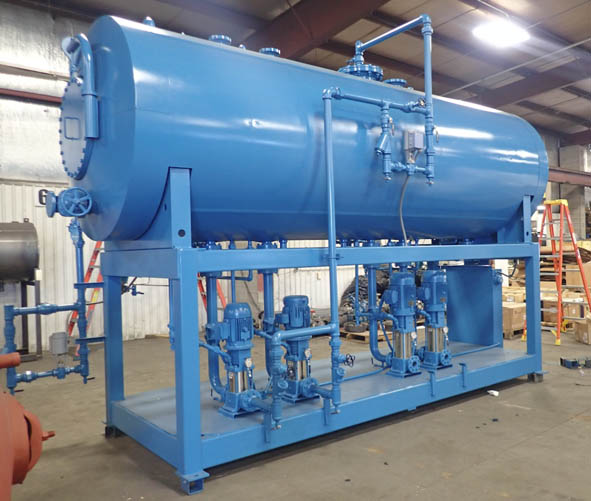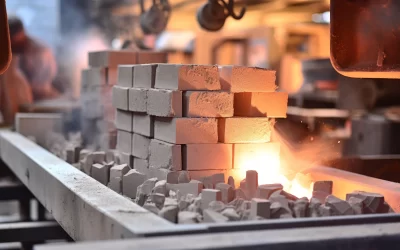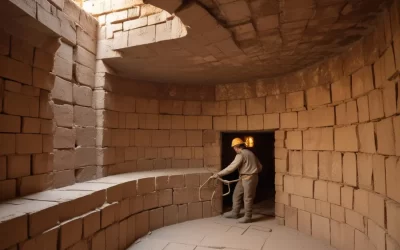Deaerator Tank is a complex machine that removes gases that have dissolved in the boiler feedwater. The steam system is protected from corrosive gases by deaeration. It achieves this by lowering the concentrations of soluble oxygen and carbon dioxide to a level that prevents corrosion. In most high-pressure boilers, a dissolved oxygen level of 5 parts per billion (ppb) or below is required to avoid corrosion.
Although oxygen levels of up to 43 ppb can be permitted in low-pressure boilers, reducing the oxygen concentration to 5 ppb extends system life at little or no expense. The deaerator almost fully removes carbon dioxide.
Process of Deaerator!
Deaerators come in a variety of shapes and sizes, but they always work in the same way. An inlet water connection allows feedwater to enter the DA. The steam in the tank then reacts with the end up making liquid in the tank, elevating the temperature of the water. This disperses oxygen and other undissolved gases, allowing them to flow through a hole at the DA tank’s top.
The water is subsequently cleansed with oxygen-free steam in a baffled scrubber part of the tank. After that, the steam passes through a spray valve, which transforms it into a fine layer. As the gases released leak to the environment, the water is ready to be used by the boiler.
Why Use a Deaerator!
A deaerator, as previously said, aids in the prevention of corrosion. When oxygen in the water combines with iron in the system, corrosion develops. If you don’t eliminate the oxygen from the system, the iron will! Rust will occur when the metal reacts chemically and disintegrates.
When iron reacts with water to generate Ferrous Hydroxide, the chemical process begins. The remaining iron is protected by the upper layer of Ferrous Hydroxide If there is dissolved oxygen enough, it reacts with the ferrous hydroxide to generate ferric hydroxide, which itself is rust.
Ferrous Hydroxide + Oxygen = Ferric Hydroxide (Rust)
If the dissolved oxygen in the system is constantly cycled, the ferrous hydroxide will be continuously removed from the system until the metal is completely dissolved.
Types of Deaerators!
Deaerators are classified into two types: spray and tray. It’s worth noting that there are additional forms of DAs, but we’ll concentrate on the two most frequent.
Deaerator Spray Type:
Spray-Type Deaerators function as both a deaeration section and a storage tank for boiler feed water.
A spray-type deaerator is typically a horizontal tank with a preheating part and a deaeration section. The two portions are separated by a baffle. Low-pressure steam reaches the vessel through a sampler in the vessel’s bottom. The feedwater spray nozzle and preheat portion work together to heat the boiler feed water to saturation temperature. This makes it easier to remove the dissolved gases in the subsequent deaeration stage.
The warmed feed water finally travels into the deaeration portion, where the steam emerging from the sparger system deaerates it. Gases extracted from the water leave through the vessel’s top vent. The pumps then transport boiler feed water from the vessel’s bottom to the thermal boiler system.
Deaerator Tray Type:
The Tray-Type Deaerator is a vertically installed domed deaeration portion on top of a horizontal cylindrical tank. The vertical deaeration portion above the perforated trays receives boiler feed water and flows downhill via the perforations.
Low-pressure deaeration steam arrives beneath the perforated trays and rises through the perforations. Rather than perforated trays, several designs employ various forms of the packed bed. This allows for good contact and mixing of the steam and boiler feed water.
The steam extracts the dissolved gas from the boiler feed water and leaves via the vent gate at the dome section’s top.
The water drains into the horizontal storage tank and is pushed to the steam-generating boiler system. The stored boiler feed water is kept heated by low-pressure heating steam. This joins the horizontal vessel via a sparger pipe at the vessel’s bottom.
WRAPPING UP!
Thank you for reaching here. I hope you have found this blog helpful and informative. Let’s have a quick look at how we can help you as a service provider. read more about the Boiler feedwater system.
So, Ganesha’s is a prominent thermal dereators manufacturer in India, with solutions for removing gases that have dissolved in the boiler feedwater.





